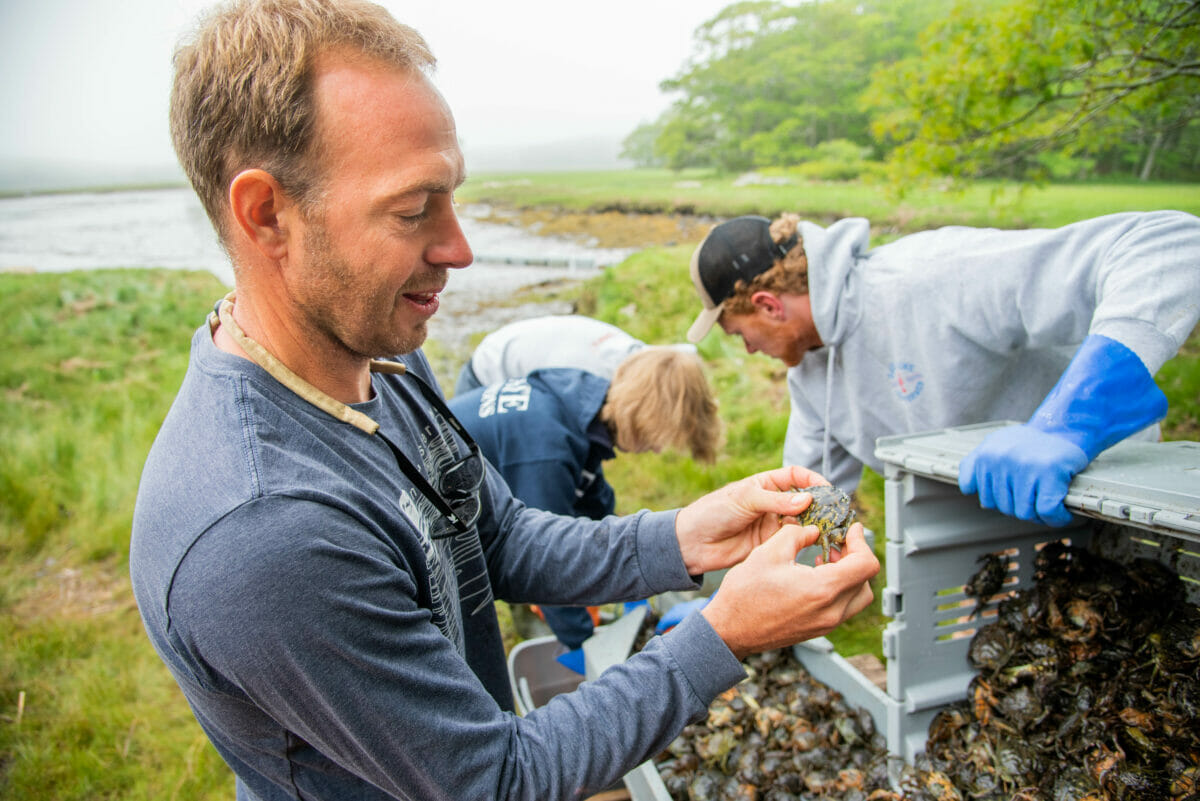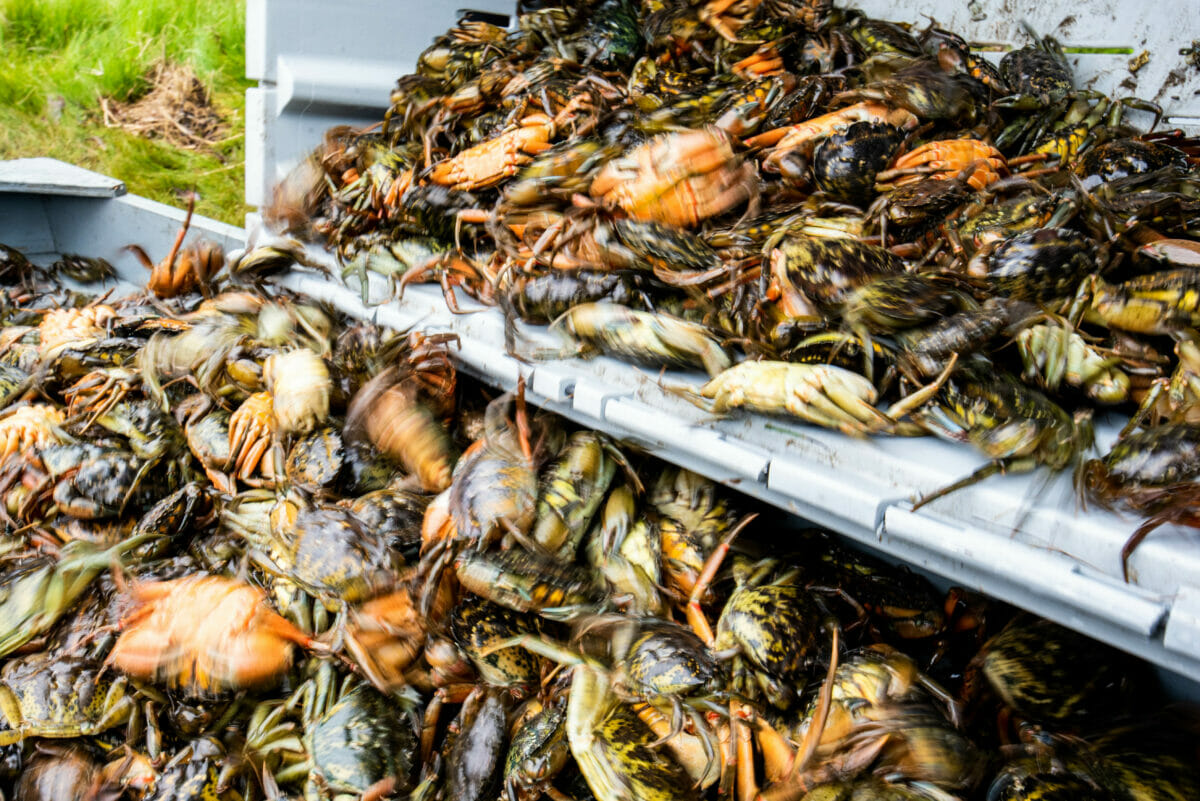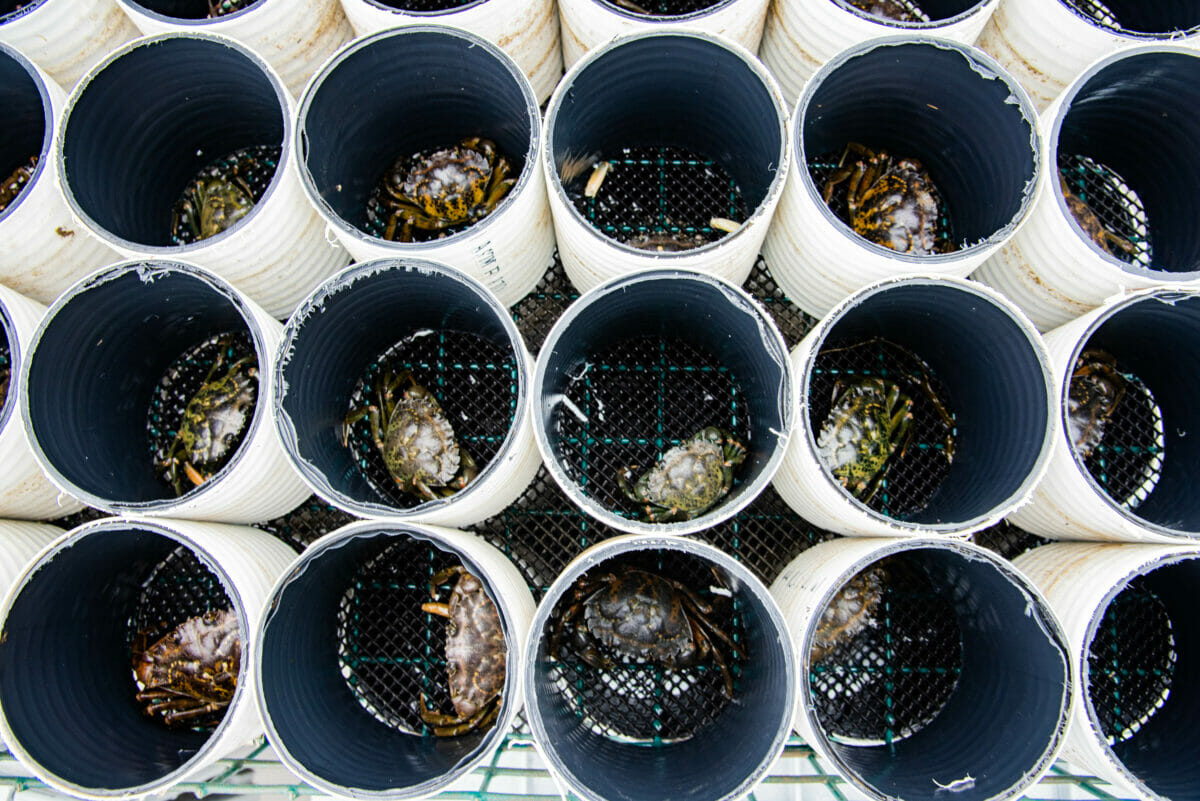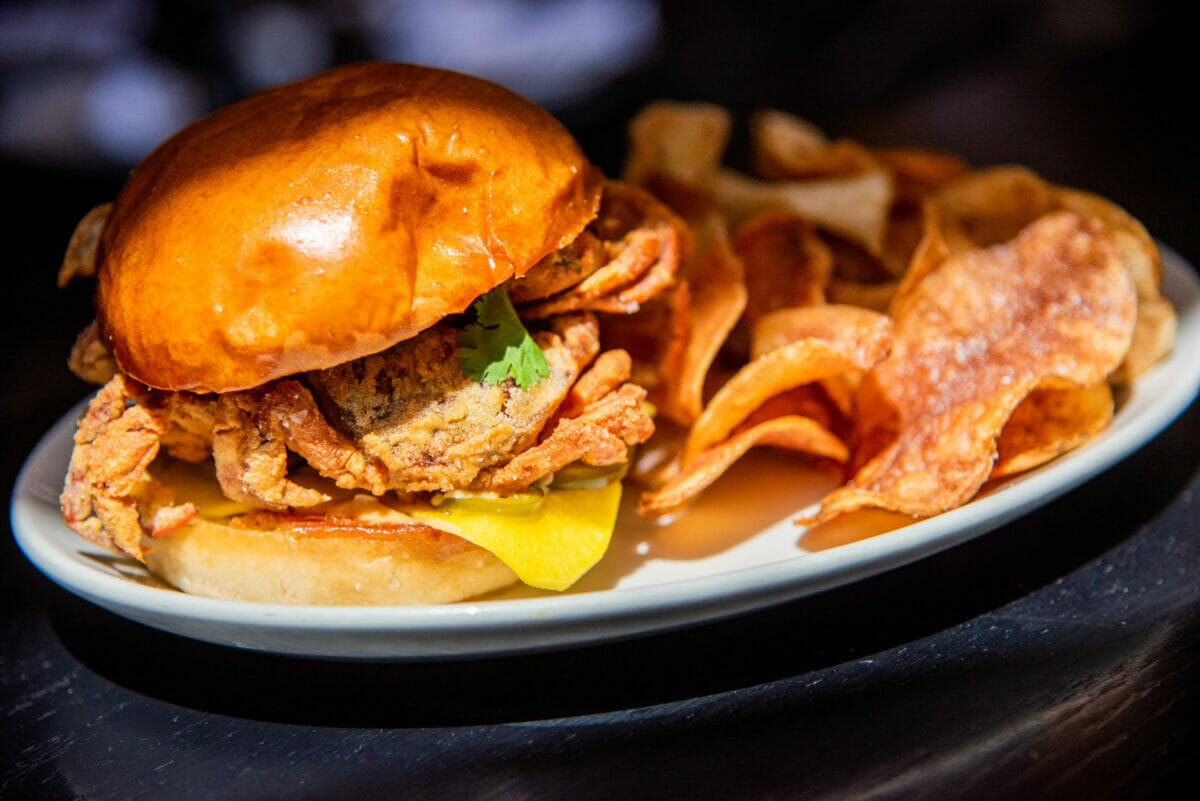Can Finding New Culinary Markets for Green Crabs Help Curb the Invasive Species?
Up and down the East Coast, fishers, chefs and distillers are pioneering new uses for an overwhelming population of European green crabs.
Can Finding New Culinary Markets for Green Crabs Help Curb the Invasive Species?
Up and down the East Coast, fishers, chefs and distillers are pioneering new uses for an overwhelming population of European green crabs.

Green crab harvester Mike Masi holds a freshly molted green crab, pressing on its shell with his thumbs to feel the soft leathery shell.by Tim Briggs.
The bad news about green crabs is that they’re pretty much everywhere. At least, that’s the case up and down much of the East Coast, from Nova Scotia to South Carolina. Flip over a rock and they’ll go running. There’s a certain sound they make darting through the mud and seaweed. It’s a wet clicking and squelching of claws that seems to spill from the rocks. It sticks with you.
Despite their abundance in the area, green crabs aren’t actually native to this part of North America. Their origin can be found in their full name: the European green crab. First introduced to these shores more than 150 years ago, they’ve made their mark.
Growing up in York, a small town on the coast of Maine just over the border with New Hampshire, Mike Masi spent many days looking for crabs. His mother worked nights at the local hospital and after shifts she would drop him and his siblings at the small beach nearby where friends could keep an eye on them.

“We were beach rats. Always clambering around the rocks and tide pools and stuff like that,” says Masi. “Now, I’ll tell you, at no point did I think that there was a future in that.”
But 30 years later, after a jaunt in California—where he studied marine science and worked on a great white shark diving boat—and a baker’s dozen of years spent working in education, Masi is back in the same waters looking for the same crabs he used to pull out of the knots of seaweed. Green crabs, that is.
The Threat of Invasive Green Crabs
Like all the best (or worst) invasive species, green crabs are voracious eaters, hard to kill, prolific parents and thrive in many environments. In ecology, the term ecosystem engineer refers to species that build and modify their habitat. Beavers engineer intricate dams, creating ponds that radiate life outwards. Green crabs are engineers placing explosives on load-bearing columns and beams, demolishing the ecosystems where they’ve been introduced, deftly disassembling the connections that hold everything together.
They eat seemingly anything, including each other. They devour mussels, oysters and soft-shell clams, which are sometimes called steamers. One of the most valuable commercially harvested marine species in the state of Maine, soft-shell clams have been decimated by hungry green claws. They also undermine salt marshes, causing the creeks and channels to collapse and the marsh to wash away.
But the bad news about green crabs—and their abundance—is good news for Masi. That’s because he’s fishing for them as a source of food.

Masi first fished for green crabs with his marine science students at York High School, where he taught until 2021. He and his students applied for a grant from the York Sustainable Fisheries Fund, a local nonprofit, to monitor populations of green crab in the York River. The grant got them a few traps, Masi found a skiff to putter around the river and, suddenly, he and his students were catching pounds and pounds of green crab.
Fishing, however, is not the challenging part of harvesting green crabs. “If you’re using good bait,” Masi says, ”you can catch 30 to 40 pounds in a trap on a one- to two-night set.” The hard part is that green crabs are best eaten soft-shell, just after they’ve molted and shed their exoskeleton in order to grow into a new, larger shell. Unlike with lobster or a larger crab such as Dungeness, picking the meat out of a green crab isn’t very rewarding. They’re small crabs, with shells a few inches wide at most, and their spindly legs aren’t especially meaty. But in their soft-shell form, you can eat the whole crab—just like the prized soft-shell blue crab from the Mid-Atlantic.
In order to get a freshly molted crab, you catch as many crabs as you can and then figure out which are about to molt. Each crab goes into a unit in a “condo”—trays made from mesh to prevent fighting or cannibalism (remember, green crabs will eat each other if they’re hungry enough). The condo complexes (crates) stay in the water and you check them for molted crabs at every low tide. Molted crabs are obvious—suddenly one condo unit holds two crabs. One is empty, the old shell discarded like dirty laundry, and the other is the fresh molt, soft like wet leather and ready to be cooked.

Identifying crabs that are about to molt is a muscle that must be trained. It’s closer to an art than a science, although Masi had help from a scientist to learn. Gabriela Bradt from New Hampshire Sea Grant and UNH Cooperative Extension has worked to build a green crab fishery for years. Masi was first inspired to give commercial fishing for green crab a shot after hearing Bradt speak at a local event.
Male green crabs molt in early summer in York, Maine. The male molt is more intense and concentrated than the female, making for better fishing. In the first week of June, Masi and his crew were working in overdrive: Fishing, sorting, checking; rinse, repeat. Checking every low tide sometimes means checking at midnight as the tides swirl around the clock, advancing an hour each day.
The rarity and inexact art of identifying pre-molts makes this fishery a numbers game. “This is not a small batch operation,” Masi explains. “This is ‘catch them by the million and find the three, four percent that are useful and do something with them.’” Each haul of the trap has been close to 90 percent female, and not every male is a pre-molt. Some are shiny and green, a crab with a new hard shell. The ones that got away.
Finding New Uses for Green Crabs
Playing a numbers game with such an abundance of green crabs tends to up your odds of success, and even hard-shell crabs can be useful. Buyers of the invasive green crabs have included whelk fishermen using the crabs as bait and a local Buddhist temple for Cambodian New Year, where they were pickled for a Cambodian dish called Salty Crab. One New Hampshire distillery, Tamworth Distilling, has used green crabs to flavor a whiskey (although the crabs weren’t Masi’s).
Masi’s soft-shell green crabs are finding wider success in restaurants in York and nearby Portsmouth, New Hampshire, a picturesque riverside outpost for sea-foodies on the highway to Maine.
Ryan Boyd, culinary director of Row 34, has been buying them whenever possible from Masi. Row 34 is a restaurant with a focus on oysters, beer and seafood—most of it local—with locations in Portsmouth, Boston, Cambridge and Burlington. He first tasted green crabs through Masi’s business partner Sam Sewall, nephew of Row 34 owner Jeremy Sewall.
“Last year, [Sam] brought in six crabs in a homestyle-like little box and I’m like ‘What is this craziness?’” recalls Boyd. “We fried them up and I was like, ‘These are really good, dude. If you ever have more of these, give me a call.’”

This year, the menu features green crabs in the form of a soft-shell crab slider with hoisin aïoli and pickled daikon. Boyd stacks three fried crabs on a bun, breaded legs poking out where you usually see a patty. “Usually, one [order] goes to the restaurant, through the dining room, and then everyone kind of head-turns, ‘Oh, what’s that?’ And then all of a sudden you sell three, four more. It’s a bit of a showstopper,” Boyd says.
The unique thing about the green crab fishery, at least in New England, is the benefits beyond employment that it offers. By Masi’s rough math of 10 crabs per pound, they’ve removed about 35,000 green crabs from their small estuary and the York River. The ease of fishing so many crabs means they aren’t going to solve the green crab problem overnight—which is good if you’re trying to make a fishery out of it—but they have seen a decrease in their catch in the harbor where they do most of their fishing.
Masi sees an opportunity for localized preventive fishing for green crab, especially around soft-shell clam habitat. A town interested in keeping its clam beds alive could pay someone like Masi to set traps and fish them. Masi sees potential for a much bigger fishery in the future, and he isn’t shy about sharing his techniques.
“We’re going to put it out there for other harvesters to take it or leave it and see if they want to try to join in,” he says. “Because there’s certainly no shortage of [green crabs] and they’re selling at restaurants really quickly. So, we haven’t even come close to hitting demand.”
Everyone seems to be rooting for the green crab fishery to succeed—unusual for most commercial fisheries. “You’re harvesting, feeding people, employing people and doing ecological good. That’s extremely rare,” says Masi. “And so it feels great to be a part of that.”
Follow us
This work is licensed under a Creative Commons Attribution-NoDerivatives 4.0 International License.
Want to republish a Modern Farmer story?
We are happy for Modern Farmer stories to be shared, and encourage you to republish our articles for your audience. When doing so, we ask that you follow these guidelines:
Please credit us and our writers
For the author byline, please use “Author Name, Modern Farmer.” At the top of our stories, if on the web, please include this text and link: “This story was originally published by Modern Farmer.”
Please make sure to include a link back to either our home page or the article URL.
At the bottom of the story, please include the following text:
“Modern Farmer is a nonprofit initiative dedicated to raising awareness and catalyzing action at the intersection of food, agriculture, and society. Read more at <link>Modern Farmer</link>.”
Use our widget
We’d like to be able to track our stories, so we ask that if you republish our content, you do so using our widget (located on the left hand side of the article). The HTML code has a built-in tracker that tells us the data and domain where the story was published, as well as view counts.
Check the image requirements
It’s your responsibility to confirm you're licensed to republish images in our articles. Some images, such as those from commercial providers, don't allow their images to be republished without permission or payment. Copyright terms are generally listed in the image caption and attribution. You are welcome to omit our images or substitute with your own. Charts and interactive graphics follow the same rules.
Don’t change too much. Or, ask us first.
Articles must be republished in their entirety. It’s okay to change references to time (“today” to “yesterday”) or location (“Iowa City, IA” to “here”). But please keep everything else the same.
If you feel strongly that a more material edit needs to be made, get in touch with us at [email protected]. We’re happy to discuss it with the original author, but we must have prior approval for changes before publication.
Special cases
Extracts. You may run the first few lines or paragraphs of the article and then say: “Read the full article at Modern Farmer” with a link back to the original article.
Quotes. You may quote authors provided you include a link back to the article URL.
Translations. These require writer approval. To inquire about translation of a Modern Farmer article, contact us at [email protected]
Signed consent / copyright release forms. These are not required, provided you are following these guidelines.
Print. Articles can be republished in print under these same rules, with the exception that you do not need to include the links.
Tag us
When sharing the story on social media, please tag us using the following: - Twitter (@ModFarm) - Facebook (@ModernFarmerMedia) - Instagram (@modfarm)
Use our content respectfully
Modern Farmer is a nonprofit and as such we share our content for free and in good faith in order to reach new audiences. Respectfully,
No selling ads against our stories. It’s okay to put our stories on pages with ads.
Don’t republish our material wholesale, or automatically; you need to select stories to be republished individually.
You have no rights to sell, license, syndicate, or otherwise represent yourself as the authorized owner of our material to any third parties. This means that you cannot actively publish or submit our work for syndication to third party platforms or apps like Apple News or Google News. We understand that publishers cannot fully control when certain third parties automatically summarize or crawl content from publishers’ own sites.
Keep in touch
We want to hear from you if you love Modern Farmer content, have a collaboration idea, or anything else to share. As a nonprofit outlet, we work in service of our community and are always open to comments, feedback, and ideas. Contact us at [email protected].by Tim Briggs, Modern Farmer
June 27, 2022
Modern Farmer Weekly
Solutions Hub
Innovations, ideas and inspiration. Actionable solutions for a resilient food system.
ExploreExplore other topics
Share With Us
We want to hear from Modern Farmer readers who have thoughtful commentary, actionable solutions, or helpful ideas to share.
SubmitNecessary cookies are absolutely essential for the website to function properly. This category only includes cookies that ensures basic functionalities and security features of the website. These cookies do not store any personal information.
Any cookies that may not be particularly necessary for the website to function and are used specifically to collect user personal data via analytics, ads, other embedded contents are termed as non-necessary cookies.
Believe a greater effort should be made to market these crabs to Asians, specifically Chinese, Japanese and Koreans. They like any sort of seafood. Way back in Korea saw people sucking tiny cooked snails out of shells, ate them while watching movies. Might even be an export market..
Can eyestalk ablation be used to induce molting? Place crabs in individual “condos”, ablate the eyestalks, feed them well, and periodically check for molting.